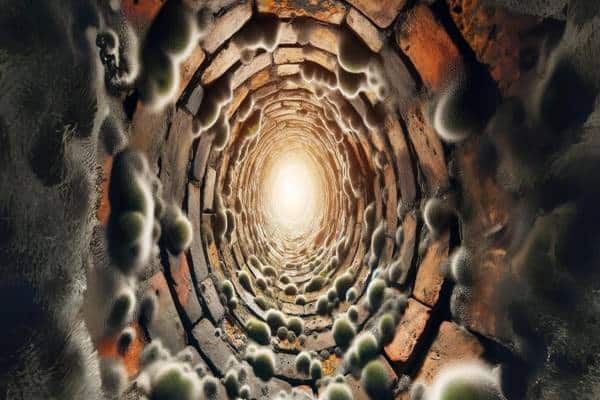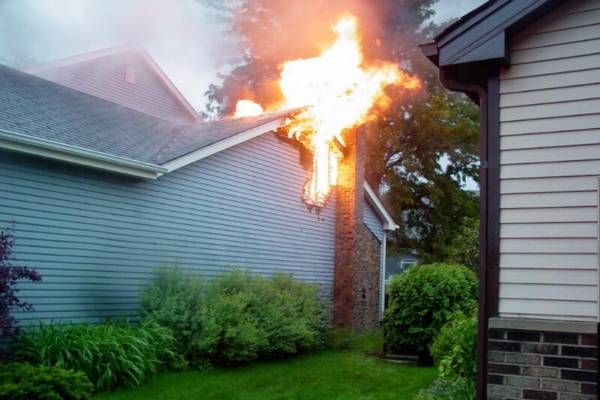It's true that many people don't even think about mold in their chimneys! But guess what? This mold isn't just playing hide-and-seek; it can be a bit of a troublemaker.
Learning about this moldy visitor in your chimney and fireplace is important.
Why? Because keeping your home safe and healthy is mandatory.
So, Let’s tackle this mold together and keep our homes happy and damage-free!
Identifying Mold in Your Chimney
Ready to be a mold detective? Here's how to spot those sneaky mold spooks in your chimney:
- Visual Inspection: Those could be mold's secret hideouts if you see weird black or green spots on your chimney!
- Odor Detection: If your chimney smells like old, wet socks, that musty, earthy scent hints that mold is absolutely present in there.
- Health Symptoms: Feeling more sneezy or cough lately? If your chimney's got mold, it might be causing those irritating respiratory troubles.
Health Symptoms Indicate Molds In Air Ducts
Mold in your air ducts isn't just a household issue—it's a health concern, too. Here's what experts say you should watch for:
- Eye, Nose, Throat Irritation: A common reaction to mold is irritation in these areas, particularly noticeable when the air conditioning is running.
- Chronic Headaches Indoors: Experiencing headaches that seem to disappear outside but return inside can be a strong indication of black mold in your ventilation system.
- Allergy: Signs like a runny nose, itchy eyes, and skin rashes while indoors are often associated with mold exposure.
- Dizziness and Fatigue at Home: Feeling unusually dizzy or tired when inside your house can also point to mold in your air ducts.
Understanding the Risks of Chimney Mold
Chimney mold poses several risks:
1. Health Risks
Mold is sneaky and can make you feel sick without you even realizing it. If you're allergic to mold or have asthma, it's even worse.
It can make you cough, sneeze, and feel pretty miserable. And if it sticks around for a long time, it can lead to some really serious health stuff.
2. Damage to Your Home
But it's not just about us; mold can be really bad for your house, too. It can eat away at the bricks and mortar in your chimney, making it weak.
And before you know it, this mold can spread to other parts of your house and cause some big-time damage.
3. Musty Smell
Have you ever walked into a room and smelled something like old, wet socks? That's probably mold. It smells musty and kind of gross, and sometimes, it can even make you feel sick to your stomach.
4. Fire Hazard
In some cases, mold and the associated moisture can lead to blockages in the chimney. This can pose a fire hazard, especially in chimneys used for venting smoke from fireplaces or stoves.
5. Deterioration of Chimney Linings
Mold and the moisture accompanying it can corrode metal and clay chimney linings, leading to leaks and inefficiencies in venting.
6. Increased Maintenance Costs
The presence of mold might necessitate more frequent cleaning and potentially costly repairs to address any damage caused to the chimney and surrounding areas.
7. Legal and Insurance Issues
- Non-Compliance with Safety Standards: If mold leads to significant structural damage, your chimney might not comply with local safety standards, potentially leading to legal issues.
- Insurance Claim Rejections: Insurance companies may reject claims for chimney repairs if the damage is due to neglect, such as failing to address mold issues promptly.
Removing Mold from Chimney
For mold removal:
- DIY Methods: This involves using a bleach-water solution, vinegar, or tea tree oil and a stiff brush. Remember to wear protective gear like gloves and masks.
- Professional Services: Due to the complexity and risks, hiring a professional chimney sweep is often the safer and more effective option. They have the tools and expertise to remove mold thoroughly and safely.
Preventing Future Mold Growth
Prevention strategies include:
1. Keep It Dry
- Mold loves moisture, so the key is to keep your chimney as dry as possible.
- If you find any leaks around your chimney, get them fixed right away.
2. Good Ventilation
- Make sure your chimney has good airflow. This helps keep it dry and mold-free.
- If you're unsure about ventilation, a chimney expert can check it for you.
3. Regular Cleaning
- Clean your chimney regularly. This means having a professional come and sweep it out.
- Regular cleaning gets rid of stuff that mold could grow on.
4. Use a Chimney Cap
- A chimney cap is like a little hat for your chimney. It keeps rain and snow out, which helps prevent mold.
- It also keeps out birds and critters that might bring in moisture or things mold can grow on.
5. Check for Cracks
- Sometimes, chimneys get little cracks. These can let in water, which leads to mold.
- Have a pro check for cracks and seal them if they find any.
6. Use Mold Inhibitors
- After cleaning, you can use special products called mold inhibitors.
- These help stop mold from growing back.
7. Watch for Signs:
- Look for any signs of mold, like a musty smell or black spots.
- If you see anything, call a chimney expert to take a look.
Conclusion
Mold in your chimney is a serious issue that requires immediate attention. Regular maintenance, proper waterproofing, and professional inspections are key to preventing mold growth and ensuring a healthy living environment.




